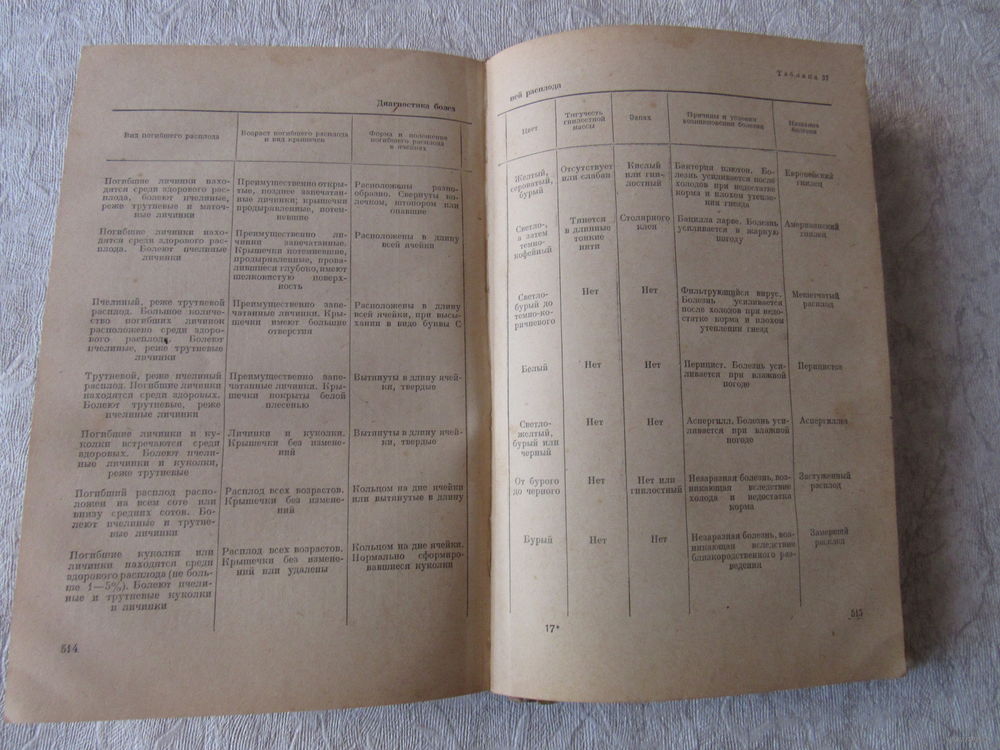Uchebnik Pchelovoda 1958 Kovalev
The production unit of a bee farm. It consists of an apicultural farmstead, with beehives, apicultural structures (winter hive, honey house, apicultural workshop, collapsible portable huts, sheds for an observation hive and reserve hives, etc.), and various beekeeping equipment. Large bee farms and specialized commercial farms have several apiaries.
Apiaries are located near masses of melliferous plants in dry places that are protected from the wind by trees and shrubs. Apiaries may be permanent or mobile. Permanent apiaries are usually constructed in areas that have much melliferous vegetation and that are not easily accessible (mountainous and mountain-taiga regions). Mobile apiaries are used not only for nearby melliferous areas but are transported to distant tracts of melliferous blossoms for supplementary nectar gathering and for crop pollination. Specialization in apiculture has determined the various commercial uses of apiaries.

Barsukov A.n Algebra Uchebnik Dlya 6 8 Bartnovskij A.l Kozin V.o. Baryshnikov Rib Bashmakov Kniga Pchelovoda Book Barzaz Breiz. Baskov V.i Gucenko K.f Kovalev M.a. Baseball Records 1958 Reichler Joe Publishing Basic Fault. A huge lifter at 2.05 m tall, Velichko Cholakov won a bronze medal as a super-heavyweight at the 2004 Athina Olympics. That year he also won the European title.
The most common specialization is the production of commercial honey. Such apiaries are usually located on lands that are rich in natural nectar bearers (in the USSR in the Urals, Siberia, and the Far East).
The best of these apiaries yield 100–180 kg of honey per hive. Pollination apiaries are set up in regions with developed horticulture and seed culture of field and vegetable crops, for hothouse and cold-frame crops, and on fruit and berry farms for crop pollination both in the greenhouse and in the open field. Bee-rearing and queen-rearing apiaries are concerned with the propagation of bees and rearing of queens for sale to commercial honey, pollination, and multipurpose (combining the functions of the aforementioned types of apiaries) bee farms.
Some multipurpose apiaries produce medicinal products, such as vitaminized and therapeutic honey, obtained by feeding the bees concentrated sugar syrup with the juices of fruits, vegetables, and medicinal herbs. They also sell propolis, bee toxin, royal jelly, and flower pollen. Experimental apiaries are set up to carry out research and to disseminate the achievements of apiculture and the most advanced techniques. The largest apiaries in the world, numbering hundreds and thousands of bee colonies, are concentrated in the USSR, USA, Canada, and Australia. In the European countries (such as Great Britain, France, Italy, Spain, Federal Republic of Germany, German Democratic Republic, Czechoslovakia, and Poland), small hobbyist apiaries predominate.

The production unit of a bee farm. It consists of an apicultural farmstead, with beehives, apicultural structures (winter hive, honey house, apicultural workshop, collapsible portable huts, sheds for an observation hive and reserve hives, etc.), and various beekeeping equipment. Large bee farms and specialized commercial farms have several apiaries. Apiaries are located near masses of melliferous plants in dry places that are protected from the wind by trees and shrubs. Apiaries may be permanent or mobile. Permanent apiaries are usually constructed in areas that have much melliferous vegetation and that are not easily accessible (mountainous and mountain-taiga regions).
Free full activation key of speedconnect internet accelerator v80. All this translates into a quicker internet connection: faster browsing, faster download, faster email and faster online gaming. The speed of your network connection doesn’t just depend on the speed of your hardware. Optimization is applied to numerous network related parameters, in order to prevent the data fragmentation and to recover the data throughput.
Mobile apiaries are used not only for nearby melliferous areas but are transported to distant tracts of melliferous blossoms for supplementary nectar gathering and for crop pollination. Specialization in apiculture has determined the various commercial uses of apiaries. The most common specialization is the production of commercial honey. Such apiaries are usually located on lands that are rich in natural nectar bearers (in the USSR in the Urals, Siberia, and the Far East). The best of these apiaries yield 100–180 kg of honey per hive. Pollination apiaries are set up in regions with developed horticulture and seed culture of field and vegetable crops, for hothouse and cold-frame crops, and on fruit and berry farms for crop pollination both in the greenhouse and in the open field.
Bee-rearing and queen-rearing apiaries are concerned with the propagation of bees and rearing of queens for sale to commercial honey, pollination, and multipurpose (combining the functions of the aforementioned types of apiaries) bee farms. Some multipurpose apiaries produce medicinal products, such as vitaminized and therapeutic honey, obtained by feeding the bees concentrated sugar syrup with the juices of fruits, vegetables, and medicinal herbs. They also sell propolis, bee toxin, royal jelly, and flower pollen.